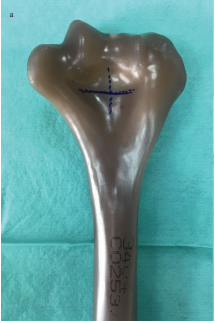Objective: The aim of this study was to biomechanically assess the effect of humeral-fenestration size in the Outerbridge-Kashiwagi arthroplasty on the ultimate failure load of the distal humerus in a synthetic bone model.
Methods: We biomechanically tested the influence of different humeral-fenestration sizes on the failure load of the distal humerus in Outerbridge-Kashiwagi arthroplasty. A total of 50 synthetic humerus models were divided into 5 groups based on the fenestration size: 10 mm, 12 mm, 15 mm, 18 mm, and 20 mm. All the samples were randomly assigned to receive either axial or anteroposterior (AP) loading and then loaded to failure at a rate of 2 mm/min on a material testing machine. The data regarding ultimate failure loads under the axial and AP loading were analyzed.
Results: Under the AP loading, the mean ultimate failure loads of the 18 mm and 20 mm groups were lower than those of the other groups. Under the axial loading, the mean ultimate failure load of the 10 mm group was significantly greater than that of the 15 mm, 18 mm, and 20 mm groups. Additionally, the ultimate failure load of the 20 mm group was significantly lower than that of the 12 mm, 15 mm, and 18 mm groups.
Conclusion: The distal humeral fenestrations with a size greater than 18 mm may offer poor biomechanical properties in the Outerbridge-Kashiwagi ulnohumeral arthroplasty.
Cite this article as: Hong CK, Hsu KL, Kuan FC, Wang CH, Wang PH, Su WR. The effect of hole size on failure loads of the distal humerus fenestration in Outerbridge-Kashiwagi arthroplasty: A biomechanical study. Acta Orthop Traumatol Turc 2020; 54(3): 305-10. DOI: 10.5152/j.aott.2020.03.59.



.png)
.png)

